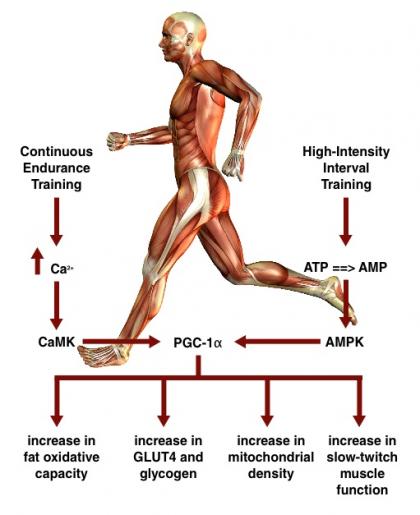1st set (very slow, intense movements)
Push-up to failure (about 20)
Wide arm pull-up to failure (about 9)
Squat (two 35 lb weights) to failure (about 10)
2nd set
Military push-up to failure (10)
Reverse grip narrow-grip pull-up to failure (10)
Squat (two 35 lb weights) to failure (10)
3rd set
Wide arm push-up (15)
Overhang narrow-grip pull-up to failure (6)
Squat (two 35 lb weight) to failure (10)
And we're off. It was a good workout and I think a good start to my training. I've made it a goal to post after every workout. I promise not to workout between posts as that's the whole point of my project. However, I do take 5K walks pretty regularly with my wife and dog so that will continue. That doesn't even count, right? Right...?
I wanted to take a few moments to briefly talk about the underlying principles behind this project:
Principle One: The Pareto Principle (Less is More)
My workouts will consist mainly of high intensity interval training (HIIT). The latest science seems to support the idea that conventional aerobic training and HIIT produce similar adaptive changes in muscles that allow for increased efficiency, athleticism and power.
Your muscles are comprised of three types of muscle fibers:
- Type 1 - Slow-twitch (for the endurance): they take awhile to exhaust, oxidative and recover quickly
- Type 2a - Fast-twitch oxidative: aerobic and anaerobic, store glycogen, useful for power, recover slowly
- Type 2b - Fast-twitch glycolytic: anaerobic, all power, takes a week to fully recover, store glycogen
The important point is that slow aerobic workouts engage slow-twitch muscles. Weight lifting and sprinting, however, exhaust fast-twitch muscles and their glycogen stores. The majority of muscle glycogen is stored in these fast-twitch fibers but how often does a typical american engage these muscles? Not often. Generally, when you weight train, you initiate these muscles in sequence with slow-twitch trying to lift the weight first, then type 2a fast twitch and then finally when all else fails, type 2b fast twitch. Once the fast-twitch muscles are engaged, it takes 5-10 days for them to recover. It's similar to a cut on your arm. It doesn't usually heal in 3 days. In fact, it takes about 5-10 days! It takes roughly that duration of time for micro tears in your muscle to heal and the adaptive process to take shape after a strenuous, fast-twitch muscle inducing workout. I never understood the whole "workout every three days" advice. When I used to lift weights every three days, I felt like I was never fully recovered. It was only during those accidental weeks where I had been too busy to work out and a week had gone by that I noticed marked improvement in my strength from the previous session.
The majority of your cardiovascular health improvement can come by simply taking more walks, mowing the lawn, or taking the stairs instead of an elevator. You'll be at the proper heart rate for endurance training when you go for a long walk without the added stress and overuse injury that plagues most chronic aerobic exercisers.
Principle Two: Nutrition is Key
I've more or less, for the past 5 months, been on a paleo diet. I follow an 80/20 rule because there are certain experiences (like going out to eat) that I just enjoy. Having said that, I feel healthier than I have been in a long time. I can go into a bunch of health benefits I've experienced with this diet as it has helped me to lose a good deal of weight. However, there are a lot of websites and books out there that can do a better job explaining the diet than I ever could. Suffice to say, my diet has been and will mostly consist of:
The 80%
- Fruits
- LOTS OF VEGETABLES - it angers me that people, especially paleo people, take this diet as a license to eat a hell of a lot of bacon. It isn't.
- Lean meats: mostly organic, grass fed.
- Oily Fish: We like salmon. I like shrimp (not technically fish) and I love canned sardines.
- Some nuts though I don't consistently eat these.
- Dark Chocolate...it's a treat
- Bread/Pasta. It's a once in awhile treat because my wife is an excellent bread maker. Bread, in general, however is a nutrition devoid carb bomb.
- Desserts
I do not eat processed foods. They are pretty easy to spot. It's anything that wouldn't exist if it wasn't for modern science...for the most part. If you can't kill it or pull it out of the ground, it's probably not good for you. One could argue, in fact, that foods like bread are some of mankind's original processed foods. Grain seeds were never a part of our repertoire until we figured out a way to grow it, harvest it, pulverize it, ferment it and enjoy it.
Principle Three: Get Plenty of Rest and Relax(ation).
I think this principle speaks for itself. Whatever you can do to make sure you sleep well enough, do so. I've had some trouble with this over the past year. Recently, I discovered that I could have been chronically dehydrated. After spending the last week or so consciously willing myself to rehydrate more often, my sleep has infinitely improved. If you're having trouble sleeping, whatever the cause may be, it's definitely worth doing what you need to do to fix it.
Also, plenty of relaxation is required. Your body needs time to recover. I also work about 50 hours a week so recovery during down time is critical. Lastly, relaxation, preferably with loved ones, is just good for the mind and soul.
These are my principles. What do you think?


No comments:
Post a Comment